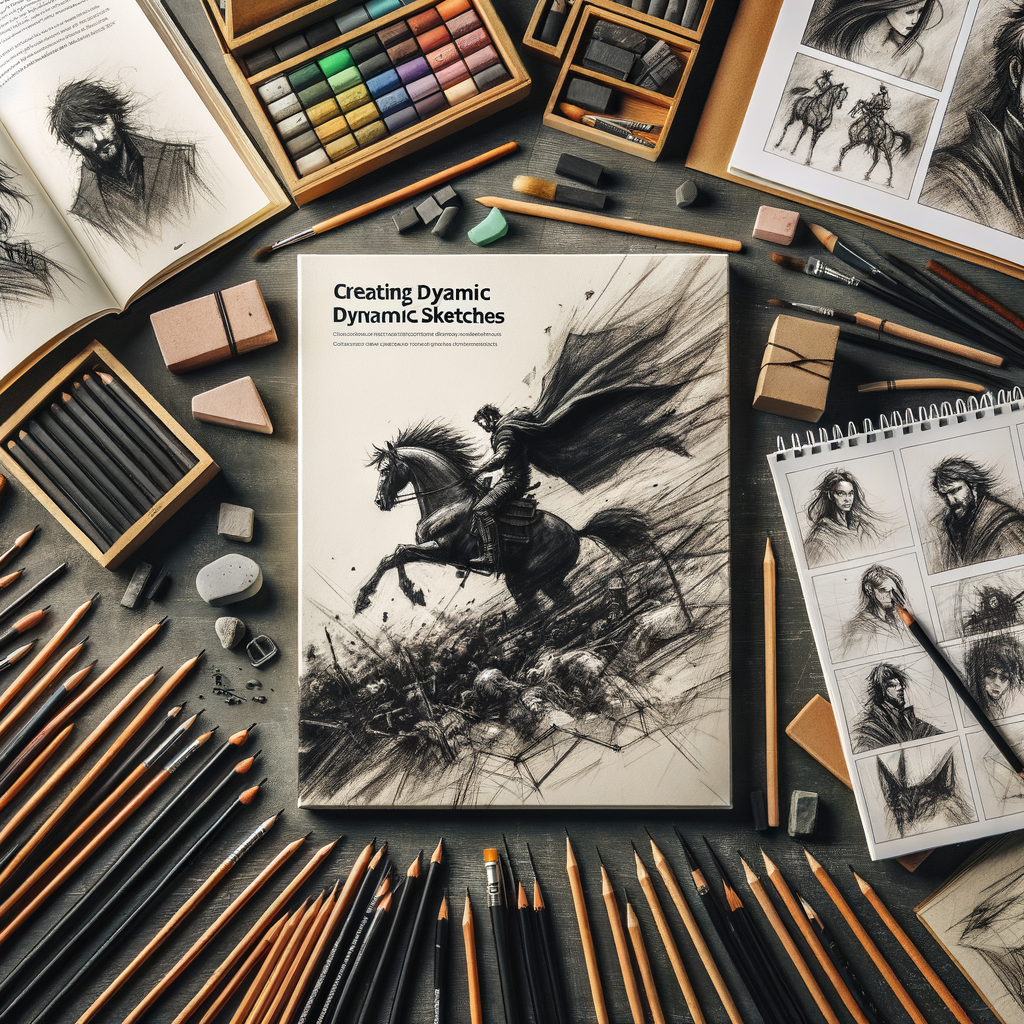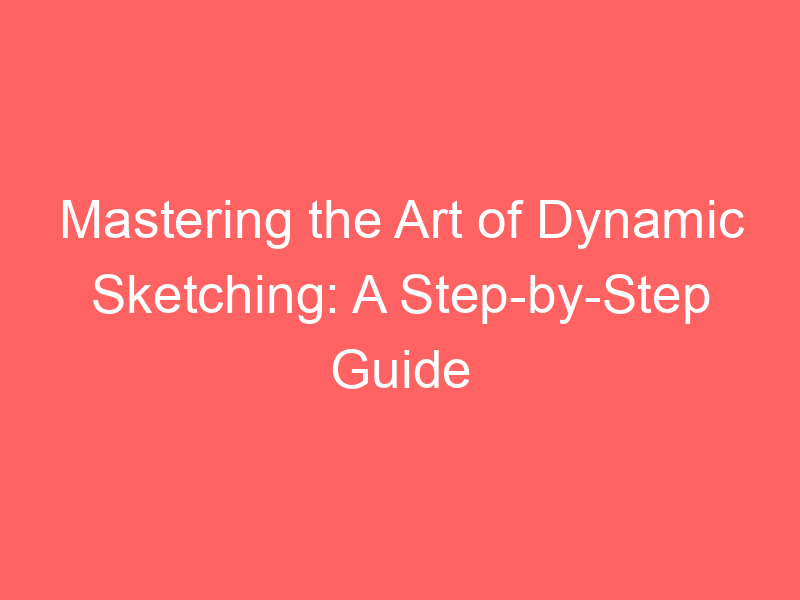
Introduction to Dynamic Sketching
Dynamic sketching is a unique and powerful approach to drawing that can transform the way artists create their work. It’s about capturing the essence of your subject, rather than focusing on every tiny detail. This introductory guide will help you understand the concept of dynamic sketching and its importance for artists.
- Understanding the Concept of Dynamic Sketching
- Importance of Dynamic Sketching for Artists
Dynamic sketching is a method of drawing that emphasizes the movement and energy of the subject. Instead of creating a static, detailed representation, artists using dynamic sketching aim to capture the essence of the subject in a few quick, expressive strokes. This approach is often used in fields like animation and concept art, where speed and expressiveness are key. Wikipedia has a great article that delves deeper into the concept of sketching.
Dynamic sketching is a crucial skill for artists for several reasons. Firstly, it helps artists to improve their observation skills and understand the underlying structure of their subject. Secondly, it allows artists to create more expressive and lively drawings. Lastly, it’s a great way to quickly capture ideas and concepts. In essence, dynamic sketching is about learning to see the world in a new way and translating that vision into your art.
Whether you’re a seasoned artist or a beginner, understanding and practicing dynamic sketching can significantly enhance your drawing skills. So, let’s dive deeper into this exciting technique and learn how to bring more life and energy to your sketches.
Dynamic Sketching Tutorial: The Basics
Dynamic sketching is an exciting approach to drawing that brings life and movement to your artwork. This tutorial will guide you through the basics of dynamic sketching, helping you to create more engaging and expressive sketches.
Sketching Techniques for Artists: Getting Started
Before you dive into the world of dynamic sketching, it’s essential to understand some fundamental sketching techniques. Here are three key steps to get you started:
- Choosing the right materials
- Understanding the basic elements of sketching
- Practicing basic sketching exercises
Having the right materials can make a significant difference in your sketching experience. A good quality sketchbook and a set of pencils with different hardness levels are a great start. The graphite pencil is a popular choice for sketching due to its versatility and range of shades.
Sketching is more than just drawing lines on a paper. It’s about understanding shapes, forms, and perspectives. The basic elements of sketching include lines, shapes, forms, values, space, and texture. Mastering these elements will provide a solid foundation for your dynamic sketching journey.
Like any other skill, sketching improves with practice. Start with simple exercises such as drawing basic shapes, shading, and creating textures. Gradually move on to more complex subjects. Remember, the goal is not to create a perfect drawing, but to understand and apply the basic principles of sketching.
Dynamic sketching is a journey of exploration and creativity. As you learn and practice these basic techniques, you’ll find your sketches becoming more vibrant and expressive. So grab your sketchbook and pencils, and let’s get started!
Creating Sketches Guide: Advanced Techniques
As you continue to grow as an artist, it’s important to explore advanced techniques that can help you create more dynamic sketches. This guide will focus on how to develop your own unique sketching style.
Art Tutorial for Sketching: Developing Your Style
Developing your own sketching style doesn’t happen overnight. It requires patience, practice, and a willingness to experiment. Here are some steps to help you on your journey.
- Exploring different sketching styles
- Creating your own unique sketching style
Before you can develop your own style, it’s important to understand and appreciate the variety of sketching styles that exist. From realistic to abstract, each style has its own unique characteristics and techniques. Spend some time studying different styles, try replicating them, and see which ones resonate with you. This exploration can serve as a foundation for developing your own style. You can find a wealth of information on different sketching styles on Wikipedia.
Once you’ve explored different styles, it’s time to start creating your own. This process involves combining elements from different styles that you like, adding your own personal touch, and continuously refining your technique. Remember, your style should be a reflection of you – it’s not about copying someone else’s style, but about expressing your own unique vision and voice. Practice regularly, be open to feedback, and don’t be afraid to make mistakes – they’re all part of the learning process.
In conclusion, developing your own sketching style is a journey of self-discovery. It’s about finding your voice as an artist and expressing it through your sketches. So, keep practicing, keep exploring, and most importantly, have fun with it!
Drawing Dynamic Sketches: Tips and Tricks
Creating dynamic sketches is an art that requires practice and understanding of some key principles. Here, we will share some valuable tips and tricks that can help you master this art.
Artist Sketching Tutorial: Mastering the Art
Mastering the art of sketching is not an overnight process. It requires patience, practice, and a keen eye for detail. Here are some steps you can follow to improve your sketching skills:
- Improving your observation skills
- Mastering the art of shading
- Creating depth and perspective in your sketches
Observation is the key to great sketching. The more you observe, the better you get at capturing the essence of your subject. Practice observing everyday objects and scenes, and try to sketch them. This will help you understand shapes, proportions, and details better. Drawing is all about seeing and understanding what you see.
Shading is what gives your sketch depth and dimension. It helps create the illusion of light and shadow, making your sketch look more realistic. Practice different shading techniques such as hatching, cross-hatching, and stippling. Remember, the direction and intensity of your shading can dramatically affect the mood and realism of your sketch.
Creating depth and perspective in your sketches is crucial for making them look three-dimensional. Understanding the rules of perspective and how to apply them to your sketches can greatly enhance their realism. Practice drawing objects from different angles and distances to improve your understanding of perspective. Remember, the key to creating depth is understanding how objects relate to each other in space.
Remember, the key to mastering the art of sketching is practice. Keep sketching, keep observing, and keep improving. With time and patience, you will see your sketches come to life.
Guide to Dynamic Sketching: Case Studies
Let’s delve into real-life examples of dynamic sketching. These case studies provide valuable insights into the process and techniques of successful artists, and how they overcame challenges in their sketching journey.
Sketching Tips for Artists: Real-Life Examples
-
Case Study 1: Successful Dynamic Sketching
Consider the case of Pablo Picasso, a renowned artist known for his dynamic sketches. Picasso’s sketches were not just simple lines on paper; they were a representation of his thoughts and emotions. He used a variety of techniques, such as hatching, cross-hatching, and stippling, to add depth and texture to his sketches.
One of his famous sketches, “The Bull”, is a perfect example of dynamic sketching. Picasso started with a detailed sketch of a bull and gradually simplified it into a few lines, capturing the essence of the bull. This demonstrates the power of dynamic sketching – the ability to convey a lot with minimal lines.
-
Case Study 2: Overcoming Sketching Challenges
Next, let’s look at the case of Vincent van Gogh. Van Gogh struggled with sketching in his early years. He found it difficult to control his lines and often ended up with stiff and lifeless sketches.
However, Van Gogh didn’t give up. He practiced relentlessly, studied the works of other artists, and experimented with different techniques. Over time, he developed his unique style of sketching, characterized by bold lines and dramatic swirls. His sketch “The Starry Night” is a testament to his mastery of dynamic sketching.
Van Gogh’s journey teaches us that challenges are part of the sketching process. It’s through overcoming these challenges that we grow as artists.
These case studies highlight the importance of practice, experimentation, and perseverance in mastering dynamic sketching. Remember, every artist has their unique journey. Don’t be disheartened by initial challenges; instead, view them as opportunities to learn and improve.
Learning Dynamic Sketching: Key Takeaways
As we conclude our exploration of dynamic sketching, it’s crucial to remember the key insights that can help you improve your drawing skills. Let’s recap some of the most important points we’ve discussed.
Tutorial for Creating Sketches: Final Thoughts
- Recap of dynamic sketching techniques
We’ve covered a variety of techniques in our dynamic sketching tutorial, from basic line drawing to advanced shading and perspective. Remember, the key to dynamic sketching is capturing the energy and movement of your subject. This can be achieved through loose, flowing lines and a focus on the overall form rather than the minute details. For more information, you can refer to Wikipedia’s article on sketching. - Importance of continuous practice
Like any other skill, sketching improves with practice. The more you draw, the better you’ll become at capturing the essence of your subjects in a dynamic and engaging way. Try to sketch every day, even if it’s just for a few minutes. Remember, every drawing is a step forward in your artistic journey. - Encouragement for further exploration and creativity
Finally, don’t be afraid to experiment and explore your own unique style. Art is a form of self-expression, and there’s no right or wrong way to do it. Be bold, be creative, and most importantly, have fun with your sketching. The world of art is wide and diverse, and there’s always something new to learn and discover.
In conclusion, dynamic sketching is a valuable skill that can add life and energy to your drawings. With practice and creativity, you can create stunning sketches that truly capture the essence of your subjects. So grab your sketchbook and start drawing – the world is your canvas!





